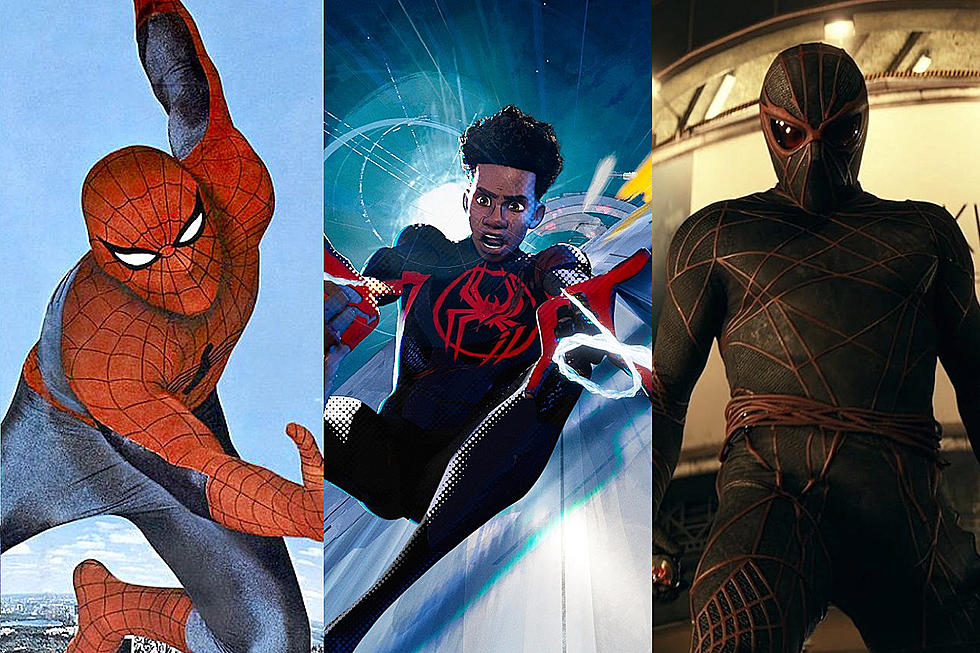
The Uatu The Watcher Memorial Awards: The Best Comic Books Of 2014, Part Four
The last twelve months offered comic book readers a wide variety of work ranging from the most crowd-pleasing superhero epics to the most idiosyncratic of indies, and the return of old favorites to the emergence of exciting new talent. It was a busy and productive year for the industry, and one we’re pleased to celebrate with what we’re certain will be an uncontroversial, unenumerated list of awards that will prompt only resounding agreement and unbroken fellowship amongst our readers in the comments below. Welcome to part four of ComicsAlliance’s Best Comic Books of 2014.
Click here for PART ONE.
Click here for PART TWO.
Click here for PART THREE.
About the Uatu the Watcher Memorial Awards
Marvel has been in a state of constant rolling events since Avengers Vs. X-Men, with each multi-part series feeding off the last, setting up the next, and touching almost everything around it. If you're the sort of reader who finds it a little oppressive and overwhelming, just think how toga-toting bobblehead Uatu Watcher felt. That guy's whole life was an unrelenting crossover, and he had to watch the alternate reality versions as well. That guy saw everything, including his own impending death -- and it's little wonder that he went with the flow and took the easy out. Live by the event, die by the event; that was the Watcher's way.
Uatu the Watcher was shot dead by Nick Fury (I'm pretty sure), who then took his place as the official Marvel Universe weirdo who spies on everyone from a remote hidey-hole on the moon, because we'd hate to not have a guy doing that important work. Uatu the Watcher is survived by his wife Ulana, and his son, a creepy floating head.
BEST CHRONICLE OF ADOLESCENCE
THIS ONE SUMMER
Artwork and lettering by Jillian Tamaki
Written by Mariko Tamaki
Published by First Second Books
Available: Amazon / Comics StoresIt was so wonderful to see Mariko and Jillian Tamakis’ chronicle of adolescence go beyond critical acclaim into straight up hype this year. It's a breathtaking comic. The panels of swimming alone are among the most nakedly emotional work I’ve ever encountered. But it’s the small observations that really get me: the stick Rose picks up while cycling to Windy's house, the bucket of shampoo and conditioner floating beside Windy's inner tube, the Dud's knobbly jawline. I have little in common with Rose, but her story almost felt like remembering something I’d forgotten.
When I interviewed Jillian Tamaki at SPX this year, she mentioned that her teen years were when emotions first started to feel real and important. This One Summer is an incredible portrayal of female adolescence because that understanding and experience bleeds through every panel. It is sweet and sad and perfect and it deserves every inch of praise it gets.
BEST COMIC WRITTEN BY CHARLES SOULE
SHE-HULK
Artwork by Javier Pulido, Ronald Wimberly and Munsta Vicente with Kevin Wada
Written by Charles Soule
Lettering by Clayton Cowles
Edited by Jeanine Schaefer, Tom Brennan and Frankie Johnson
Published by Marvel Comics
Available: Amazon / ComiXology / Comics StoresAlso a contributor to Superman/Wonder Woman, Letter 44, Superman, Thunderbolts, Inhuman, Original Sins, Godhead, Swamp Thing, Death of Wolverine, Red Lanterns, Legends of the Dark Knight, The Logan Legacy, and Wonder Woman, Charles Soule spent the year writing twenty eight percent of all comics, alongside his continuing work as a practicing lawyer. I believe he also still works his childhood newspaper route, hosts a babysitting club every week, and his first record “Soule Music” will be released on vinyl in the New Year. A slightly busy year for him.
She-Hulk, the best of his comics in 2014, stuck out because of the clear way he identified with the life of Jennifer Walters, herself a practicing lawyer and overworked hero. This was the year Marvel attempted to give a social life to all their 'solo' heroes, but She-Hulk’s authenticity shone through and gave the book a real feel of something ‘different’. For one thing, the legal jargon all sounded pretty accurate and the social aspects of legal life felt genuine and whole. Having created a layer of authenticity, he then went off and threw complete nonsense at the character for an extended period of time.
That contrast between the fairly honest legalese and robot punching made She-Hulk the proper successor to the ‘Hawkeye style' of comics, which Marvel have been chasing all year. When she’s ‘not’ in the Avengers, what does She-Hulk do? Stuff which is far more entertaining than the stuff she does in the Avengers! She has a unique voice amongst superheroes at Marvel, in that she tends to thoroughly love what she does whilst retaining a quiet sense of authority, and Soule took one of Marvel’s most underappreciated characters and gave her the showcase she’s been missing for years.
Also: Javier Pulido.
BEST SUPERHERO COMIC (DEAL WITH IT)
ONE-PUNCH MAN
Artwork by Yusuke Murata
Written by ONE
Published by VIZ Media
Available: Amazon / ComiXology / Comics ShopsThere were some good superhero comics this year, but for my money, the best was ONE and Yusuke Murata’s One-Punch Man. It’s funny, it’s violent, it’s frequently stupid and it has more heart packed into it than almost anything else on the stands. Also, it features characters named Grad School Graduate, Spring Mustache, Jet Nice Guy, Tank Top Tiger and roughly one million more, all of them just as golden.
One-Punch Man is the serialized adventures of a guy named Saitama who decides one day to be “a hero for fun,” and embarks on a strenuous training regimen that alows him to defeat any enemy with one punch.
My favorite moment, and the one that solidified itself on my list for 2014, comes in volume 3 (Viz released five digital collections this year) and involves a nebbish mid-level hero in a suit who fights with a group named the Blizzard Bunch. His group encounters an enemy named Demon Fan, but our guy freaks out, and somebody else on his team ends up beating the evil robot fan monster. Our guy has a bit of a career crisis, saying that he can’t be a hero because he doesn’t have a superpower, that these gifted people are born different than people like you or me, and that no matter how hard he tries, he’ll never be good enough to be a hero. Enter Saitama–a guy who got his super-strength through exercising so hard he went bald–who shows up just as Demon Fan is reforming and, true to his name, defeats him with one punch. Afterward, Saitama suggests to the guy that, instead of giving up, maybe he just needs to try harder. The chapter ends with the guy quitting the Blizzard Bunch and taking the advice to heart. We see him out jogging, inspired to train as hard as he can to be a true hero.
It’s a heartening idea, that anybody can be a hero if they try hard enough. Saitama’s not perfect; he often comes across as an oblivious dick, but he’s very sincere in his desire to be a hero and to help people. Especially if “helping people,” means punching monsters to literal pieces. That’s kind of exactly what I’m looking for in a superhero comic.
HUNKIEST SHIRTLESS SUPER SPY
GRAYSON
Artwork by Mikel Janin and Jeremy Cox
Written by Tim Seeley and Tom King
Lettered by Carlos M. Mangual
Edited by Kate Kubert, Mark Doyle and Matt Humphreys
Published by DC Comics
Available: ComiXology / Comics Stores/ Amazon Pre-OrderI'm going to be real with you for a second here: When Dick Grayson was unmasked in the pages of Forever Evil, I was 100% sure that nothing good was going to come of it. I've never really bought the idea that DC editorial is hellbent on killing off the original Robin (because they've talked about it so much that there's really no way for it to be a surprise anymore), but still. If nothing else, it stretches even my suspension of disbelief to the breaking point to imagine a world where nobody would think that Bruce Wayne's kid being revealed as one of Batman's sidekicks would completely shatter that whole secret identity thing he's been keeping up for the past 75 years. In any case, I definitely wasn't expecting it to lead to one of the best new directions for a character I've ever read.
I have to imagine that it's difficult to do something new with a character who's been around since 1940, but freeing him of his superhero identity has allowed Seeley, King and Janin to do something amazing, throwing Dick Grayson into a world of superhero espionage, full of men with unseeable faces and guns for eyes, where he's a triple-agent among double-agents.
When the first issue came out, I said that my favorite thing about it was that it was one of the first books of the "New 52" era to feel like it was part of a larger cohesive DC Universe, and as the series continued -- including the single best Future's End tie-in and a pretty fantastic Annual -- that's been the case. This is the book that's picking up on all the stuff that Grant Morrison's long run on Batman left in the universe to play with, the book that brought Helena Bertinelli back, and that made a better case than anything for the Wildstorm heroes to be a presence in the DC Universe.
Plus, this thing's like 90% shirtless hunk superheroics, and that's a level ComicsAlliance can get behind.
BEST COMIC ABOUT ETHICS IN VIDEO GAMES JOURNALISM
IN REAL LIFE
Artwork by Jen Wang
Written by Cory Doctorow
Published by First Second Books
Available: Amazon / Comics Stores
In Real Life, by Cory Doctorow and Jen Wang, was the sort of well-timed release that nobody could plan for. Though based on a ten-year-old short story by Doctorow, the themes explored in this adaptation are perhaps more resonant today than ever before.The book tells the story of Anda, a young woman who discovers her own strength of character and learns about the complexities of the wider world through an immersive online roleplaying game. It arrived on bookshelves on the tail of this year's exhausting '#GamerGate' campaign to hound women out of video games (under the thin diguise of a supposed campaign for journalistic ethics).
Gorgeously brought to the page by Wang, In Real Life is a glimpse of the new now, of how video games have become part of our everyday lives and a vital tool of self-expression for marginalized people -- represented here both by Anda, a young women, and Raymond, an over-worked Chinese worker who she befriends. Comics offer the same power, the same methods of escape and expression, and In Real Life has the power to inspire new fans in both media. Jen Wang is a tremendous storyteller at the vanguard of a new generation of female creators emerging from the world of illustration, while Anda is a far better fictional avatar of young women in video games than GamerGate's straw woman 'Vivian James'.
GamerGate is a doomed movement, a cry of entitled outrage from people who won't acknowledge that the world has already changed. It's also a depressing reminder that a lot of people see their online lives as an excuse to embrace lesser selves behind veils of anonymity or distance. Our online lives aren't separate from ourselves. Whether it's through our games, our art, our online communities, or just how we talk to each other on Twitter, these are our real lives -- and In Real Life marks this moment in our evolving understanding of that fact.
BEST TIME-TRAVELING DEAD BODY COMIC
BODIES
Artwork by Meghan Hetrick, Tula Lotay, Dean Ormston Phil Winslade and Lee Loughridge
Written by Si Spencer
Lettering by Taylor Esposito and Dezi Sienty
Edited by Shelly Bond and Sara Miller
Published by Vertigo
Available: ComiXology / Comics Stores / Amazon Pre-OrderVertigo has really latched itself onto the stories-that-jump-around-in-time motif over the past few years. The Wake had a time jump, Trillium was about a love that spanned centuries, and now, the eight-part miniseries Bodies written by Si Spencer takes the motif to a whole other level: London detectives in four different time periods (1890, 1940, 2014 and 2050) find the same dead body and investigate it in their own way. That concept alone is pretty fascinating, but add to the mix four different artists who cover each time period (Dean Ormston, Phil Winslade, Meghan Hetrick and Tula Lotay, respectively), and you get something really special. Each artist, working with colorist Lee Loughridge, does an amazing job of capturing his or her time period, from the modern curves of Hetrick's 2014 to the limited color palate and charcoal look of Ormston's 1890 to the pulpy look and blue hues of Winslade's 1940 to the neon madness of Lotay's 2050. Details such as different fonts for the narration boxes make each period all the more distinct.
Add to that the story details -- 1940's detective Whiteman is a dirty cop who fled the Nazis in Poland; 2014's DS Khan is a Muslim woman dealing with modern prejudice -- and you get great period snapshots. The mystery is the hook, but it actually ends up taking a back seat to the characters' own stories.
MOST RELEVANT CHRONICLE OF EVENTS FROM 100 YEARS AGO
SALLY HEATHCOTE, SUFFRAGETTE
Artwork by Kate Charlesworth and Bryan Talbot
Written by Mary M. Talbot
Typesetting by Katy Rodda
Published by Dark Horse (NA) & Jonathan Cape (UK)
Edited by Everett Patterson and Chris Warner
Available: Amazon / Comics Stores / Dark Horse /Jonathan CapeThere has been remarkably little discussion of this book in the comics press, perhaps owing to its none-too-contemporary subject: the struggle for women's voting rights in the United Kingdom in the years immediately preceding the Great War. Also, it is a terrifically dense work, crammed with nine-panel grids and imposing political detail, to say nothing of myriad historical personages with extremely similar haircuts. There are 18 pages of text annotations, which you will probably need to consult, and a 41-item sources list available for further elucidation.
Bryan Talbot, who provides page breakdowns and lettering, is certainly known to connoisseurs as an important figure in UK comics, and both writer Mary M. Talbot and artist Kate Charlesworth have participated in prestigious recent projects -- respectively, the Costa prize-winning Dotter of her Father's Eyes, which Talbot wrote, and Nelson, an expansive UK comics art showcase to which Charlesworth contributed -- but none of them are stop-the-internet prominent, and lacking a sexy hook it's probably inevitable their new graphic novel would arrive with little fanfare from busy specialist outlets.
Here's the thing, though: Sally Heathcote is also REALLY INTENSE. Not four pages have passed before a suffragette has thrown a hatchet at the Prime Minister, and the ongoing education of the fictional Ms. Heathcote, housemaid-turned-activist, encompasses all manner of militant protest: public disruption; smashing windows; planting bombs in empty homes. They know that police beatings may follow, and that their prison hunger strikes may be legally broken by forced feeding, and what emerges, then, from this mayhem, is an old but provocative question: why does a society value the preservation of property over the bodies of people, so that people who do violence to property 'deserve' violence done onto them? In this way, all the book's slow-reading detail and convoluted interpersonal dynamics serve an added purpose: to confirm that these things indisputable happened, regarding an issue that nobody reading this comic isn't going to consider among the most settled controversies imaginable.
From there, the reader might apply its themes to contemporary agitations against what seems to be common sense today, and might be appalling illogic tomorrow, though the authors are not quite composing a paean – instead, we observe too how extremists devour each other, until the waves of history roll in to wipe it all smooth.
BEST COMIC WITH WONDER WOMAN IN IT
SENSATION COMICS FEATURING WONDER WOMAN
Edited by Kristy Quinn and Jessica Chen
Published by DC Comics
Available: ComiXology / Comics Stores / Amazon Pre-OrderThank Hera then for Sensation Comics Featuring Wonder Woman, a digital-first anthology comic in the style and format of Adventures of Superman and Legends of the Dark Knight before it. Five paper issues have been published so far, containing nine different stories. Not all of them have been winners, and the book has sometimes been organized haphazardly, usually featuring fairly terrible covers that hide the high quality comics inside, but it has given us some of the best Wonder Woman comics of the year.
Some of these have been rather straightforward stories set in pre-New 52 continuities, like Rob Williams and Tom Lyle’s “Attack of the 500-Foot Wonder Woman,” a Satellite Era Justice League team-up story; or Corinna Bechko and Gabriel Hardman’s “Dig For Fire,” a Wonder Woman vs. Apokolips story that filled all 30-pages of issue #5.
Others have been more imaginative, even wild takes, either because of their art, or their story, or some combination of the two, like Sean E. Williams and Marguerite Sauvage’s “Bullets and Bracelets,” which reimagines Wonder Woman as a literal rock star; Ollie Masters and Amy Mebberson’s Catwoman vs. Wonder Woman conflict “Morning Coffee,” in which the characters are given a bobble-headed makeover appropriate for the comedic adventure; and Neil Kleid and Dean Haspiel’s “Ghosts and Gods,” which puts the Amazing Amazon in a sort of old-school Brave and The Bold/DC ComicsPresents style team-up, here allying her and sidekick Etta Candy with Deadman.
Most notable of all the stories so far, however, is Gilbert Hernandez’s “No Chains Can Hold Her,” in which Hernandez’s very Gilbert Hernandez-esque version of Wonder Woman is captured by Kanjar Ro and ends up doing battle with Supergirl. And by “with Supergirl” I mean she both fights against her and, in perhaps the best superhero battle of 2014, she fights using her as a weapon, as Wonder Woman and Mary Marvel toss Supergirl at one another like a projectile.
BLOODIEST COMEBACK
STRAY BULLETS: KILLERS
By David Lapham
Edited by Maria Lapham and Karen Hoyt
Published by Image Comics
Available: Amazon / ComiXology / Comics Stores
After debuting the long-awaited final issue of the original series, Lapham re-introduced his crime masterpiece Stray Bullets to the world after nearly a decade away. The first issue of Killers is a perfect summation of the themes that quickly defined the classic in its first story story arc, "Innocence Of Nihilism": the corruption of youth and the early linkage of violence and sex, parents f*cking up their kids, the every-day sociopathy of suburban life, and the awesomeness of eight-panel grids. But Killers doesn't just represent a return to prior form; by the end of the series, it's apparent that Lapham and Stray Bullets have continued to evolve in their mutual absence. Killers is frightening and desperate and bittersweet like nothing else Lapham has done, and it's just the first of an ongoing series of story arcs Image will be publishing for years to come.There really is nothing like Stray Bullets. There are plenty of good crime comics being made these days, but nothing as vibrant, visceral, and honest as what Lapham does. Stray Bullets is funny, awful, and familiar; a brutally honest examination of the mayhem that people can wreak on one another; thrilling and tragic and unrelentingly human.
MOST EPIC ADVENTURE AND HEARTBREAKING ROMANCE
MY LITTLE PONY: FRIENDSHIP IS MAGIC
Artwork by Andy Price, Heather Breckel and Katie Cook
Written by Katie Cook
Lettering by Neil Uyetake
Edited by Bobby Curnow
Published by IDW
Available: Amazon / ComiXology / Comics StoresA too-big chunk of my year was spent riding the MBTA commuter rail back and forth between Boston and Salem. Reading Katie Cook and Andy Price’s My Little Pony: Friendship is Magic on my phone quickly became my absolute favorite way to pass the time -- but not, as I'd initially expected, because it’s whimsical and easy to digest at 7:30 AM. No, that became pretty obviously not the case as I spent ten minutes per panel, ogling the luxurious detail Price's work is so marked by.
Mostly, though...I was feeling things. Feeling things over pastel princess ponies TORN FROM THEIR LOVERS BY THE CAPRICE OF SPACE AND TIME! Feeling things over pastel princess ponies HAUNTED BY PAST MISDEEDS! I’d read eagerly, hoping no one could see my screen. Princess Luna gets cool battle armor! Twilight meets her favorite author! Will, the narration somberly intoned, Big Mac ever manage to fix his gazebo?
I was very literally on the edge of my seat—even wishing, at times, the ride took just a little bit longer. My Little Pony is the best kind of all-ages work: emotional, accessible, and inventive. I say this with all the pride in my 24-year-old heart: I can’t wait to join Princess Twilight and her friends on more adventures in 2015.
BEST COMEBACK BY AN ANCIENT AND FORGOTTEN PUBLIC DOMAIN CHARACTER
THE SHADOW HERO
Artwork by Sonny Liew
Written by Gene Luen Yang
Lettering by Janice Chiang
Published by First Second Books
Available: Amazon / Comics StoresIn 1944, back in the wild, "We’ll Try Anything" days of superhero comics, a particularly mysterious new crime fighter emerged in the pages of publisher Rural Home’s Blazing Comics. He wore a cape, cowl, boots, gloves, trunks and nothing else, and in a handful of adventures he and his sidekick Burma Boy battled against the Axis-allied Japanese. The creation of Asian-American artist Chu F. Hing, the Green Turtle’s face rarely appeared on-panel, as the hero generally faced away from the reader or somehow had his profile obscured by an object, and his bared skin sometimes seemed incredibly pink. Strangest of all, the hero cast a big, black, anthropomorphic turtle shadow, which had its own set of eyes and a mouth with which to look at the reader and smile.
Speculation is that the Green Turtle was intended to be the first Asian superhero, but that his publisher was pretty adamant the character not be Asian, which explains the odd coloring choices and carefully cropping out of the character’s face -- the cartoonist and publisher simultaneously pursued their own, conflicting versions of the character.
The story of the Green Turtle fascinated cartoonist Gene Luen Yang, whose works like American Born Chinese and Boxers & Saints wrestled with elements of Asian identity issues. Together with cartoonist Sonny Liew,Yang ultimately reinvented the Green Turtle for the 2014 graphic novel The Shadow Hero.
Starting with just a handful of story clues offered by the few Golden Age stories—the turtle shadow, the costume, the skin coloration—Yang and Liew extrapolate a compelling story of a young first-generation Chinese-American, the son of immigrants trying to make their way in America despite difficult odds. Ultimately he becomes that most American of all institutions: An honest-to-God superhero.
Their action-packed dramedy works as a straightforward, new-reader friendly, often quite funny superhero adventure, while it simultaneously addresses the issues of cultural and racial identity. It can be read as maybe one of the most meta superhero comics ever written, but only if you want to read it that way—it’s also one of the most entertaining and engaging super-comics of the year.
BEST EVENT COMIC TIE-IN THAT'S ACTUALLY BETTER THAN THE EVENT COMIC IT'S TYING-IN TO
YOUNG AVENGERS: HIDDEN IN PLAIN SIGHT
Serialized in Original Sins #1-5
Artwork by Ramon Villalobos and Jordan Gibson
Written by Ryan North
Lettering by Clayton Cowles
Edited by Jake Thomas, Wil Moss and Tom Brevoort
Published by Marvel Comics
Available: ComiXology / Comics StoresThe first of Marvel’s big crossover/event series of the year was Jason Aaron and Mike Deodato’s Original Sin. That was the eight-part series that began as a murder mystery, asking who killed the man on the moon and stole his eyeballs, which were full of secrets, but ended up positing an EVERYTHING YOU THOUGHT YOU KNEW WAS WRONG! retcon by which a long-time pillar of the Marvel Universe was actually a deranged lone gunman, assassinating alien threats to earth by shooting them in the head with super-guns.
It had its moments, sure, but, on average, it wasn’t very good.
But “Hidden In Plain Sight,” a five-part Young Avengers story that ran in each issue of Original Sin’s not-at-all-confusingly-named sister title Original Sins -- That was very good. It’s a rather minor side-story that uses a single scene in an earlier issue of Original Sin, in which one of the bad guys uses a Watcher eyeball as a “truth bomb” to distract New York’s superhero community by revealing retconned secrets of their own pasts.
A trio of the latest incarnation of the Young Avengers, Hulkling, Prodigy and Marvel Boy, investigate the scene, and find the villain The Hood using his evil magic hood powers to hide a building full of civilians whose heads are filled-to-the-brim with knowledge from the Watcher eye and…Okay, it sounds needlessly complicated in summary.
The point is, it’s about half the Young Avengers vs. the Hood in a high-stakes conflict with no easy answers. It’s written by Ryan North, best known for either Dinosaur Comics or the Adventure Time comic, depending on your reading preferences, and it is at times as funny as either of those… North even has little comments running along the bottom of some pages the way he did in his Adventure Time comics, the paper comic equivalent of his alt text gags from Dinosaur Comics.
It’s drawn by Ramon Villalobos in a rough but detailed style that looks close enough to that of Jamie McKelvie that it seems of a piece with the goings on of the Young Avengers title, but distinct enough from McKelvie’s style and that of Original Sin artist Deodato that it’s clear that no matter who makes up the cast or what it’s tying in to, this is really it’s own thing.
Like a lot of readers, I was pretty bummed out when McKelvie and writer Kieron Gillen’s volume of Young Avengers ended after only 15 issues. After reading “Hidden In Plain Sight,” I’m even more bummed out, as now Marvel’s let us know they had a pretty perfect Young Avengers creative team waiting in the wings, a team that would have been able to produce a pretty great All-New Young Avengers.
More From ComicsAlliance









